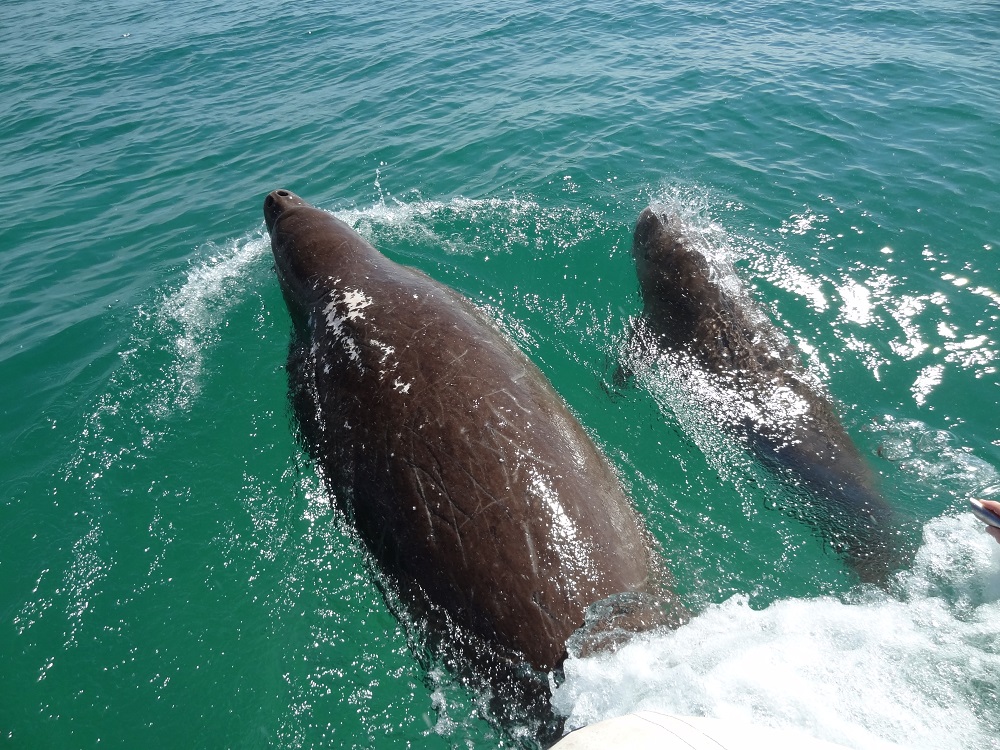
Protecting ocean giants from vessel strike
Quandamooka (Moreton Bay) is home to many of the ocean’s marine megafauna and a new report developed by Traditional Owners aims to prevent vessel strikes as boat use and shipping continue to grow.
The Quandamooka Yoolooburrabee Aboriginal Corporation (QYAC), supported by Healthy Land & Water through Australian Government funding, has led the study which proposes a series of actions to reduce the impact of marine vessels on large marine fauna such as whales, turtles, dolphins, and dugongs in Quandamooka.
Quandamooka
 The whale and her calf are under threat of boat strikes.
The whale and her calf are under threat of boat strikes.
The Quandamooka People’s ongoing custodianship was formally recognized by the Federal Court in 2011 and the Quandamooka People, represented by QYAC, now have Native Title over 71,756 hectares of land (Quandamookadjara – Quandamooka Country) and waters (Yarabindjara – Quandamooka Sea Country).
This project was borne from QYAC’s leadership and advocacy for increasing the understanding and impacts of vessel strikes on large marine animals in Sea Country and identifying options to reduce the impact of vessel strikes on these culturally significant values.
The problem – Boat strikes are impacting dugongs, whales, dolphins, and turtles
Moreton Bay, which is also known by the First Nations name of Quandamooka, is a vital hub for marine megafauna, shipping, and recreational boating. It has the highest recorded diversity and abundance of resident and transient whales and dolphins in Australia, while one in six recreational vessels in Australia are found in the Moreton Bay area.
Humpback whales migrate along the east coast of Australia and regularly visit Quandamooka to rest during their epic migration from Antarctica to the tropics.
More than 85% of Humpback whale pods in Moreton Bay have at least one accompanying calf. Mothers and calves are at higher risk of boat strike due to the shallow depths where they rest and nurse and the reduction in ‘blow’ size during this time.
Eight species of dolphin utilise Quandamooka waters including two permanent resident species: the bottlenose and the Australian humpback dolphin. Throughout the year, other marine animals visit Quandamooka’s warm waters, including killer whales, southern right whales, sperm whales, melon-headed whales, minke whales, common dolphins, spinner dolphins, and Risso’s dolphins. The bay is a critical feeding ground for six of the world’s seven species of marine turtles and also hosts the world’s southernmost population of the shy and elusive dugong.
The QYAC report highlighted that vessel strikes particularly threaten the long-term future of larger and slower animals such as the southern right whale and the loggerhead turtle. Animals that spend a lot of time at or near the surface to breathe, feed and rest are especially vulnerable and significantly more likely to experience fatality as result of vessel strike. Southern right whales are known to rest just beneath the surface where they are often undetectable to boats, leading to adverse outcomes for humans and whales.
Tackling the issue
Through this work, a range of measures have been investigated to reduce the impact of vessel strikes on marine life.
Healthy Land & Water CEO Julie McLellan said one of the measures being further assessed is a monitoring network that records the presence of large marine animals and provides warnings to nearby vessels.
“If this monitoring network is established it would enable craft operators to reduce speed, visually check for key fauna, and more readily take avoidance action.”
The report identified that existing legislation could be more effectively utilised to protect large marine animals. For example, declaring temporary special management areas in response to verified sightings of significant or high-risk species could be an effective mitigation measure.
Zoning plan for management of vessels in Moreton Bay
The waters of Moreton Bay are managed through the Moreton Bay Marine Park zoning plan, which includes several designated areas, no-anchoring, and no-take zones.
A number of these designated areas regulate vessel speed (or require vessels to travel off-the-plane or in displacement mode) to reduce vessel strikes in areas that have been identified as critical habitats for threatened species such as turtles and dugongs.
Improved communication and coordination between managers and researchers were also flagged as a priority to enable increased awareness, reporting, and self-regulation.
The report recommends a focus on First Nations leadership and stakeholder facilitation in Sea Country management. The intent is to enable a constructive flow of information between Sea Country custodians and the marine sector, including commercial operators, recreational boating community groups, and researchers.
“Increased collaboration to build collective understanding of science and policies, as well as cultural protocols and stewardship needs, and ultimately improving the collection of data are other critical areas that can support improved management,” says Ms McLellan.
Media and education campaigns targeting the broader South East Queensland community to increase understanding of marine megafauna within Moreton Bay were also identified as an important tool to support protection outcomes.
Where to from here?
QYAC Community Land and Sea Manager Darren Burns says the report aims to help inform policy and planning to reduce boat strikes at key locations within Quandamooka Country.
“The report will help us to talk with key management partners to increase protection of the Quandamooka People’s globally unique Sea Country which we believe is worthy of World Heritage listing,” says Mr Burns.
“With the Greater Brisbane population projected to increase by over one million people over the next ten years and these culturally significant mammals increasingly using Quandamooka Country, we need to minimise and manage the risk to both humans and wildlife.”
“Protecting the marine giants of Quandamooka Country is vital for a healthy future for all of us.”
This project is a collaboration between the Quandamooka Yoolooburrabee Aboriginal Corporation and Healthy Land & Water with funding support through the Australian Government’s National Landcare Program.



